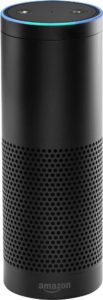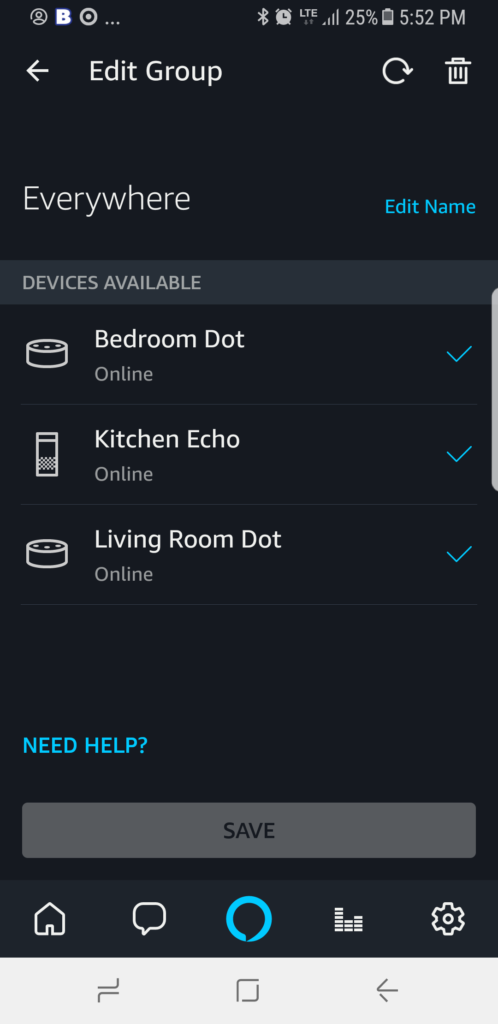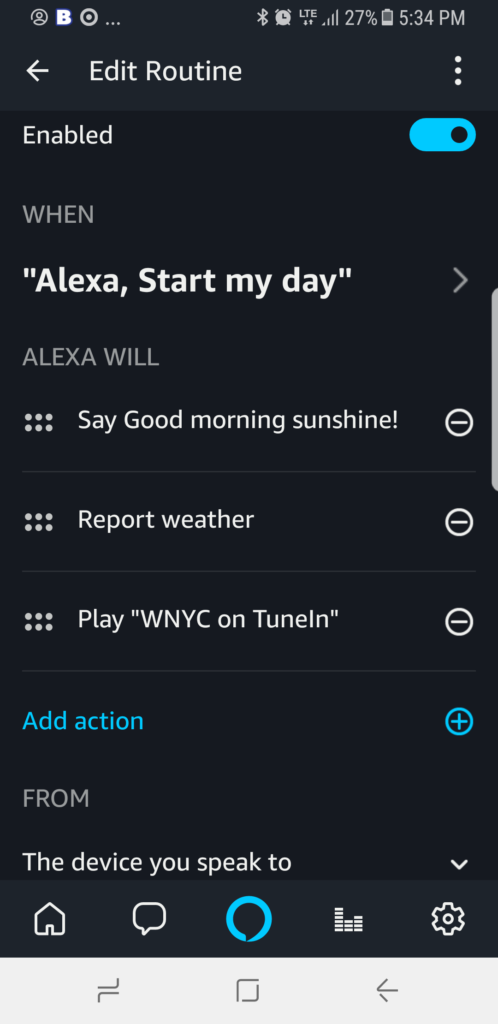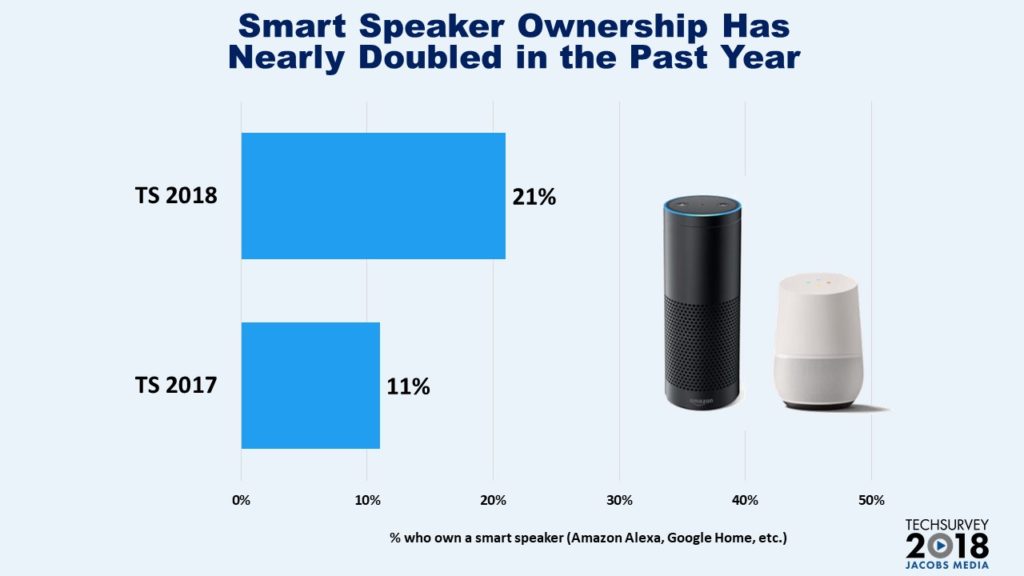 When I bought my Amazon Echo a year ago, it immediately changed my behavior at home. I suddenly found myself listening to music around the house far more often. Moreover, I found myself listening to a wider variety of music than ever before. And it wasn’t just music. Suddenly, it was easy to call up a podcast or audiobook while cooking or folding the laundry. Thanks to the Echo, audio entertainment became a far more frequent occurrence in my home.
When I bought my Amazon Echo a year ago, it immediately changed my behavior at home. I suddenly found myself listening to music around the house far more often. Moreover, I found myself listening to a wider variety of music than ever before. And it wasn’t just music. Suddenly, it was easy to call up a podcast or audiobook while cooking or folding the laundry. Thanks to the Echo, audio entertainment became a far more frequent occurrence in my home.
I recently moved into a new house, and this week I finally found the time to configure my smart speaker setup. I have an Amazon Echo, and my girlfriend has two Amazon Dots. I spent a couple of hours figuring out which device should go in which room. (FYI: A Dot in the bedroom, a Dot in the living room, and the Echo in the kitchen.) Along the way, I discovered a few of Alexa’s quirks. Here are three that radio broadcasters (and audio fans) should be aware of:
1. Devices can be grouped, but they can only belong to one group.
In the Alexa smartphone app that you use to set up your devices, you can create “Audio Groups.” This allows you to play audio on multiple devices simultaneously. So as I move from the bedroom to the bathroom to the kitchen in the course of my morning routine, I can listen everywhere I go.
Unfortunately, devices can only belong to one group at a time. So if I have a group called “Front of House” with my living room Dot and my kitchen Echo, I cannot also have a group called “Everywhere” that contains all three devices. Amazon forces you to pick and choose groups.

2. Bluetooth speakers don’t work with Audio Groups.
While the Echo has a decent speaker, the audio quality from the Dots is subpar. Normally, this is fine, because I can connect them to a quality bluetooth speaker. Unfortunately, when a device is used in conjunction with other devices through an Audio Group, the bluetooth functionality goes away. This apparently happens because there is a lag when using bluetooth, so the audio coming from the different devices would be out of sync.
One workaround is to connect the Alexa device to the bluetooth speaker through an old fashioned audio cable. Unfortunately, I moved into an older house where the wiring isn’t grounded. This means that when I have the bluetooth speaker plugged into a power outlet and connected to a Dot with an audio cable at the same time, there’s an annoying hum. So, at the moment, to get a high-quality voice-activated audio setup that doesn’t require me to manually plug or unplug any wires, I’ll have to spend more money. My advice: Before you plunk down a lot of cash down for expensive bluetooth speakers, make sure you understand how they work with Alexa’s Audio Groups.
3. Alexa Routines now include audio.
Last year, Amazon introduced “Routines,” the ability to chainlink multiple commands and give it a unique name. For example, you can create a routine called “Start My Day” containing weather and traffic actions. When you say, “Alexa, start my day,” she will read the weather and traffic reports. I was bummed to learn that Routines are limited to a short list of actions: news, weather, traffic, volume control, smart home devices (such as turning up the heat on a wi-fi thermostat), and silly Alexa sayings. No music — at least, not on the evening that I was arranging my devices.
Lo and behold, the very next day, Amazon announced that they were adding the ability to listen to music, radio, and podcasts to Routines. However, this audio can only come from a short list of audio providers: Amazon Music, Pandora, Spotify, TuneIn, iHeartRadio, or your personal library. The good news for radio stations is that this makes it possible for Alexa owners to include their favorite radio morning show in their morning Routines. The (only somewhat) bad news is that it’s only possible through a third party that radio stations have no control over.

At the Worldwide Radio Summit in May, Fred Jacobs will reveal the results of our latest Techsurvey. This year, over 550 radio stations participated and more than 64,000 radio listeners told us how they’re using new technologies. But we’ve already revealed once juicy tidbit: smart speaker ownership is exploding. In fact, it nearly doubled in a single year, with 21% of respondents reporting that they own a smart speaker, up from just 11% in 2017. The vast majority of these people own Amazon devices.

If the audio listening habits of these people change as dramatically as my own habits have, it could have significant impact on radio broadcasters. If you’re in radio and you don’t own a smart speaker, I highly recommend getting one or two to see what you learn by using them. Plus, you can write them off as a business expense!
More Digital Tips
- This One WordPress Plugin Is Responsible for 16% of Our Website Pageviews
- Radio Stations Can Drive Email Registrations With Content, Not Just Contests
- How to Repurpose Audio as Video to Promote Your Radio Station on Social Media
- Bring Your Radio DJs Together to Show Gratitude This Thanksgiving
- Three Places to Hire Freelancers for Digital Tasks
- A Simple Digital Treat to Thank Your Radio Listeners This Thanksgiving - November 13, 2023
- Interview Questions When Hiring Your Radio Station’s Next Digital Marketing Manager - November 6, 2023
- A Radio Conversation with ChatGPT: Part 2 – Promotions - October 30, 2023





I have 3 in my home and although I’m definitely older, I find that I like being able to listen to stations from my old markets. If the station creates the skill, you can listen to streams and podcasts offered by the station. Better than any app I use. I don’t carry my phone around my home, but my speakers are on all the time.
I wonder if there is any master list of station skills posted anywhere? I think SBAs would promote those on their websites and social media sites if they were easily accessible.
Denise, having Alexa devices has definitely caused me to listen to audio at home a lot more, too! I am not aware of a master list of Alexa skills from radio stations, though at the very least you should be able to access any station through TuneIn.